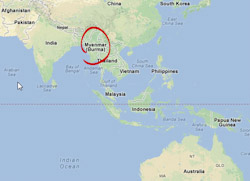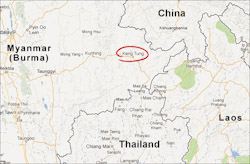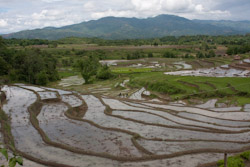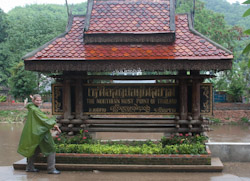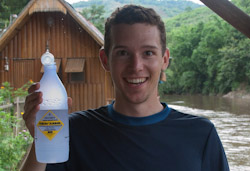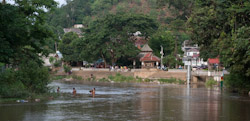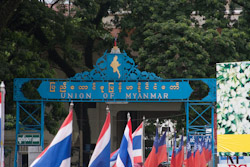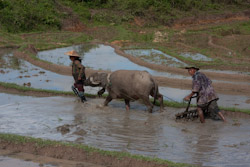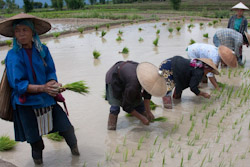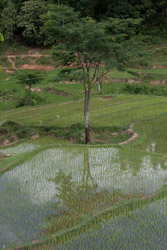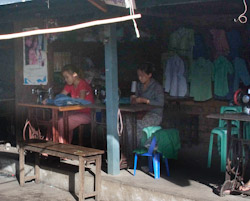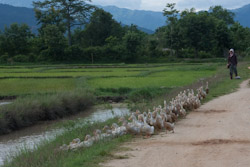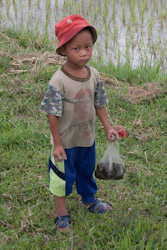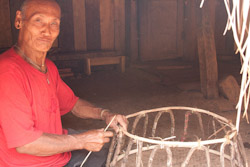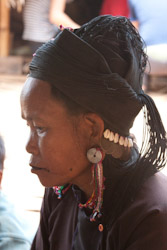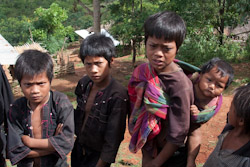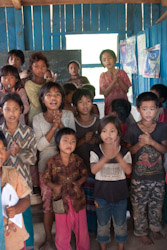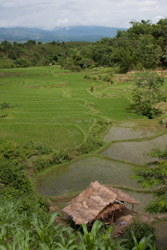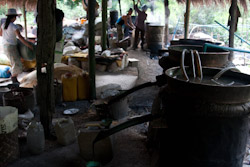
Introduction
In June 2009, my wife Natasha and I were on an extended trip through Southeast Asia. We had all the normal destinations listed on our rough itinerary: Bangkok, Chiang Mai in the north of Thailand, Halong Bay in Vietnam, Saigon, quaint Laos, and the temples of Angkor in Cambodia. Intrigued by a few paragraphs about Myanmar in our Thailand guidebook, we decided to deviate from our plan and spend a few days exploring Burma's Shan State. Comprising a large swath of Myanmar’s northern and eastern lands, Shan State is home to many non-Burmese ethnicities and has been a locus for numerous rebel movements ever since the military dictatorship took power in the 1960s. We entered the country knowing very little about it, but we left with an intense desire to learn more about this unique place.
Note: Over the course of this write-up you will notice that I switch indiscriminately between words “Burma” and “Myanmar.” The early British colonial name “Burma” comes from the name of the primary ethnic group living in the region, the “Bamar” (Burmese) people. In 1989, the military regime changed the English name from Burma to Myanmar, explaining that the name was more inclusive to minority groups. However, many argued that there were ulterior motives, and the new name has met broad resistance. Despite early concerns, many official organizations and governments, including the UN, have accepted the new name, with one major exception being the U.S. government. Thus, Americans tend to recognize the name Burma, while mention of Myanmar might be met with blank stares. The confusion and varying preferences surrounding these names is not just an international phenomenon. In the Shan State the new name is met with mixed emotions. Some despise the name Myanmar because it is seen as another attempt by the military dictatorship to exert power and control the narrative of the natives’ homelands. At the same time, they see a positive aspect in the new name because it is not specific to one ethnicity (the Burmese), who have a history of conflict with the other ethnic groups in Shan State.
Entrance
Our travels through Thailand eventually brought us to Mae Sai, a Thai town set along the river that defines the Thai-Myanmar border. Mae Sai is a trading town filled with stalls selling dried fruit, dried fish, electronics, and just about everything else. Hawkers on the street noticed our light skin and were quick to try and sell us Marlboro cigarettes, which we heard later were actually counterfeit boxes filled with cheap Burmese cigarettes! We found a nice guesthouse to stay in for the night that was located right on the river. We could sit on a deck over the river, sipping our “Yellow Surprise” brand water, and look across to Burma just 50 feet away. One of the more interesting sights was watching Burmese men stripping off their sarongs and wading across the river to get back into their home country before 6pm. The men work in the fields and on construction sites in Thailand. In what felt like a strange form of bureaucracy, the workers had two options: they could cross the bridge and pay 50 baht (~$1.50), or wade through the river and pay 10 baht (~$0.30).
The next day it was time to make out way across the border. We had a rough sense of the cost of travel in Burma and estimated that we would have enough Thai Baht on hand to convert into Myanmar “kyat” (pronounced “chot,” rhymes with “dot”) once we crossed the border. The border itself is a pretty simple affair—a concrete bridge spanning the modest Mae Sai River, with immigration officials stationed on their respective sides of the river. Departing Thailand was simple: show your passport, get an exit stamp, and then proceed to cross the bridge.
Thai and Myanmar citizens can cross the border easily for a small fee, but foreigners must proceed to the immigration desk upon getting to the Myanmar side of the border. The office was a dingy affair, a dirty room with some antiquated, dusty computers, old promotional posters, and an inkjet printer jury-rigged with external ink tanks. I guess they cannot afford the overpriced print cartridges!
The lady working at the desk was quite surprised when we said that we were from the US. “Oh, Americans. We have had quite a few come through the border here recently.” Tash and I looked at each other quizzically. Really? This place did not seem like much of a destination for anyone. Curious, I asked, “Oh, that is interesting. How many exactly?” She responded eagerly, “Two or three already this week.” We smiled as we realized that her version of “quite a few” was a pretty low threshold.
As it turns out, you can’t just get your passport stamped and then start wandering about the country—at least in the closely-watched Shan State. Quite the opposite, actually. After we paid $10 to enter Myanmar, the border officials took our passports and explained that they would create Myanmar “entry permits” for us that we would travel with in place of our US passports. “Uh, are you saying that we have to give up our US passports?” “Yes, we will keep them here for safekeeping and they will be stored securely here for pickup upon your return.” The concept of giving up my cherished US passport at the border upon entering a military dictatorship was not all that heartwarming of a concept, but “when in Rome…” We decided to just go with the flow.
The “tourism office” is adjacent to the immigration office, and we learned that we would have to arrange our itinerary and pay for our roundtrip bus fare before we could even step foot outside of the border facility. This seemed a bit strange, but it also added some convenience versus the alternative of roaming the border town aimlessly, trying to figure out transportation and lodging options. As the lady described the bus options, she ran through the costs that we should expect. They were generally in line with what we had heard, although a bit on the expensive side of what we were expecting. Plus, the exchange rate was a bit less favorable that we were expecting. I started to run the math in my head and realized that we didn’t have much margin of error given the amount of cash we had on hand. Shit. This was not good. There are no ATMs in the entire county, and there was certainly no way to get cash in the small towns we would be visiting. We had already crossed the border, so what were we supposed to do? I had no choice but to confess to the lady “I’m sorry, based on those numbers we will be a bit short on cash.” “Well, we can allow you to go back across the border and get cash from a bank. Your wife and bags can stay here.” “Ok, do I need to get my passport re-stamped or deal with any formalities?” “No, the immigration officers will know.” I looked at Natasha. She wasn’t eager to hang out alone, but it was our best option. “OK. I will do that. I’ll be right back.” I dashed off back to the bridge—no passport, no Myanmar ID card, just an ATM card in my pocket. When I reached the Thai border post I explained to the officials that I needed to go the bank and come right back. They acquiesced, and as I passed the men I tried to make sure that they got a good look at my face, hoping that they would remember me upon return. Now I was back in Thailand. If anything were to happen at this point, I would be in quite a pickle. Where is your wife? Myanmar. Where is your passport? Myanmar. Where is all of your stuff? Myanmar. Gosh, maybe this was not such a good idea.
Fortunately, it all went smoothly. As the clock ticked in my head, I waited in the impossibly slow line at the bank, withdrew the required funds, and then briskly headed back to the border. The Thai officials waved me through with barely a glance and soon I was back at Natasha’s side in the Myanmar tourism office. Let’s just say she was glad to have me back.
Now with sufficient cash on hand, bus tickets booked, and our silly looking Myanmar ID cards, we were finally ready to start our trip into Myanmar’s Shan State.
Control
We only had a short amount of time to spend in the gritty border town of Tachilek—just enough to change our money (only black market money changers are available) and realize that we were not missing much by skipping the town. The pouring rain did not make the experience any better. The tuk-tuk and motorbike drivers tried to really gouge us on the ride to the bus stop at the edge of town, but with some work we got the price down to a reasonable level. Fortunately we had our wits about us and realized that the driver had dropped us off at the wrong bus terminal before he managed to leave. A few more minutes down the road and we were finally in the right place.
We hopped on the bus and were promptly seated in the front row. It seemed odd that we were seated there, but later we learned that it was standard practice to put foreigners up front on the bus. The first thing that caught my attention was that our bus was right-hand drive (i.e., British style) but we were driving on the right side of the road (i.e., the side we would drive on in the USA). Strange, I thought. Maybe it was just that this bus was old and non-standard. So I started looking at the vehicles coming in the opposite direction. There were not many cars on the roads, but eventually some did come our way. Sure enough, they too were all right-hand drive. I had never seen such a thing. The story behind this phenomenon is quite amusing.
As a former British colony, the road system was set up with a right-hand drive system. That is, cars drove on the left side of the road with steering wheel setup on the right side of the car. That changed when the military ruler, Ne Win, issued an abrupt decree in 1970 after an astrologer advised him to "move to the right."
There were many sights to take in along the road during our five-hour bus ride. The scenery itself was stunning, with terraced rice paddies sitting in the shadows of verdant mountains. We passed many thousands of workers in the rice paddies, hunched over in arduous labor for a full day of planting under the beating sun. Water buffalo were plentiful in the fields; they are used to pull plows in preparation for planting. This was a job typically left to machinery, even in rural Thailand. The lack of machinery was clear indication of the increased poverty in Myanmar compared to neighboring countries. Most people showed signs of wear, having worked many long days exposed to the elements. Their clothes were heavily worn and their homes were run-down shanties. The military was another common sight along the road, and uniformed men seemed to be everywhere. They ranged widely in age and looked poor, often sporting visibly worn clothing. Most of them were alone or in small groups, sitting idle. Sometimes they plied the roads on rickety bicycles.
Another regular sight was the military checkpoint. Ever 10–20 kilometers we would pull over for an inspection. Sometimes the military would come on board and look around, while other times everyone had to get off the bus (except for us) to have their documents inspected one by one. There was a mother with her baby traveling on the bus, seated just a row behind us. We noticed early in the ride that she seemed nervous, and also that she appeared to be traveling with another woman. When we got to one of the checkpoints she handed the baby off to the other woman. She didn't get back onto the bus at the other side of the checkpoint. We have no idea what was going on, but it was a bit scary. As an aside, we met a Thai bicycle guide who told us an interesting story that illustrates the level of control exerted by the government:
The man was doing a bicycle tour with his buddies through Burma. All of them were Thai. They arrived in a town just before dusk and looked for a place to stay for the night. The police heard about their presence, tracked them down, and told them that no tourists were allowed in that town for the night…no exceptions. They were totally screwed. There was not enough time to ride to another town before dark. Left with no options, they just started riding out of town with no plan. Fortunately, at the edge of town there was a Buddhist temple that allowed them to stay for the night and provided some rice. Early the next morning they heard loud rumbling sounds. As they looked to the road they saw a stream of 100+ logging trucks laden with precious old-growth mahogany. The police were keeping tourists away so that they wouldn't see evidence of the illegal logging.
Incredibly, we only saw two or three private cars on the road the entire time. There were more trucks and many more motorbikes. For such an undeveloped country, we were quite surprised to see that essentially every motorbike rider was wearing a helmet. A local explained to us later: “Wearing a helmet is required by law. Not wearing one makes you a very visible target for the army/police, which pretty much guarantees that you will be hassled and have to pay a bribe.” What makes this really interesting is that everything changes at night. “Once it gets dark, no one wears a helmet while riding a bike. They know that the police do not work at night.”
After a few hours on the road, we started to grow weary of the bus ride. Often we crawled along at less than five miles per hour so that the bus could navigate around the monstrous potholes and otherwise abysmal road conditions. It was slow going, and we were relieved to finally make it into the town of Kentung. As we stepped off the bus, the bus company representative asked where we were staying in town. I responded casually, “Oh, we aren’t sure. We are going to walk around town and find a place.” The representative’s response was far more serious: “We need to know now where you are staying so we can transfer your ID card to the host.” Really? We can’t walk around town to find a place? Realizing we were stuck, I pointed to a guesthouse across the street and said that we wanted to stay there. The bus representative then walked over to the hotel with us, waited for us to confirm the price (about $15 a night), and then handed our ID cards over the innkeeper. It was a strange feeling to know that our movements were so controlled.
Insider Tales
Our guesthouse was an old colonial-era building. The interior was outfitted almost entirely with mahogany, from the walls to the floors, beds, and tables. It would cost an absolute fortune to recreate such a place in the western world. The amenities were basic, with cold showers and a stinky bathroom, but it was a place to call our own for a few days. The guesthouse was also far from max capacity—in fact, there were only one or two other people staying while we were there.
By the time we settled in it was starting to get dark. The innkeeper explained in very basic English that it was safe to walk around the town at night, so we headed off for a walk by ourselves. Our first encounter was with a crazy old lady who charged up to me in the middle of the street, grabbed my arm and demanded that I give her money. I flicked her arm away. She was a bit taken aback by my sudden movement, but after a moment of thought she immediately started stripping down to her underwear and proceeded to start dancing in the street. Wow. We were so confused. Other than that, it was a great stroll around the lake in the center of town. The lake was encircled by some fairly nice houses, a few restaurants, “tea houses” that catered to the aimless and unemployed, and even a popcorn street vendor that served us a nice snack.
Back at the guesthouse, we took some tea in the common room. One of the other guests was a relatively young guy who spoke English quite well and was eager to engage us in conversation. He said he worked in the “import/export business,” which seemed a bit suspicious to begin with. He was passing through for business, making his way from one border to another.
We chitchatted about superficial matters for a bit, but rather quickly moved on to more serious topics. As an ethnic Shan, our fellow guest was eager to tell us about the “real Burma.” For hours he shared tales of corruption, crime, poverty, and the utter lack of human rights that people face every day. Our extended conversation was punctuated only by brief periods of silence when a worker or another guest passed by the room. He was cautious with what he said around others, saying, “If anyone knew what we were talking about, I would be taken and questioned by the military. The military is everywhere.”
I have listed some of the notable parts of our conversation, but it is hard to parse out fact, fiction, and hyperbole. Also, remember that this conversation took place in 2009 in one of the most controlled regions, where the locals are worse off than people in more stables parts of Burma:
- The town we were staying in used to have a gorgeous Shan temple, but the government burned it down so that people would not have an icon to congregate around. On the plot of land the government built a hotel for officials.
- The government has banned all Shan traditional ceremonies in the town. Locals have to travel far away to less scrutinized towns in order to celebrate, so the traditions are dying out.
- Pretty much any activity that you want to undertake can incur a bribe. This includes expanding your home a bit, fixing a road, or building a school. If a village wants to build a school, they have to pay for the construction themselves AND pay a bribe to the police.
- School is supposed to be free, but teachers make $15 a month and have to collect money from students just to keep the school running. The teachers will typically have a side job or two just to be able to buy food.
- Wages in the rice paddies are $1.40 to $2.00 per day, and outside of the planting and harvesting season people are out of work.
- Medical treatment is totally unavailable to most people. Everything must be paid for up front and out of pocket. Prescriptions are only written through one pharmacy—typically the one that pays the biggest kickback to the doctor and police officials.
- People get picked up off the street and are forced to work in the military on the opposite side of the country for many years. They intentionally separate you from all of your connections so that you have no real way to escape. There are times when a guy goes out for a drink with his friends and then disappears for 4–5 years, or forever.
- Higher education in the country is only available for those who pay (generally the elite have ties to the government), and the quality is laughable. As our guide said, “I have a business degree, and I don’t really know anything about business. Everyone passes in the school if you can pay.”
- The government selectively bans western movies, music, and literature. If you are caught with any banned material and the police do not like you, the penalties can be quite serious.
- A sim card for a cell phone costs $5,000. These are artificially inflated prices designed to keep people (especially rebel groups) from being able to communicate easily. Getting a landline installed costs $2,500.
- Burma was once Asia’s largest exporter of rice, but the country didn’t invest in new technology and has now been surpassed by many others. Subsequently, the value of water buffalo has dropped from $900 to $650 as the economy has suffered.
Most of our discussion was by candlelight, as the power was out for all but a few hours during our stay. Most establishments had generators to provide power for a few hours in order to conduct business in the evenings. The man claimed that the power was cut by the government in retaliation to rebel activity in the area. I probed on this topic. “There are some pretty powerful Shan groups out here, aren’t there?” No response. This was clearly a topic too risky to discuss.
At one point in the evening another young man came by the hotel. He explained that he was a student and was also a local guide that could take us around the area. We chatted for a while and agreed on a price and rough itinerary for the next day. $35 would cover the guide, plus tuk-tuk and driver for the day. As we wrapped up our plans and negotiations, the other guest chimed in, speaking to Natasha and me loudly enough so that the guide could also hear. “Ask him [the guide] to take you over the ridgeline during your hike tomorrow.” The guide shot the guest a nasty look and said something in the local language. After the guide left, our fellow guest explained that government-controlled poppy fields were visible from over the ridgeline, and that the guide was expressly forbidden from getting anywhere in sight of such a thing. He also explained that we should have negotiated harder on the rate for the guide. “You could have paid $15, and it still would have been good money for him. There are few alternatives for making money in this town, unless you are corrupt.” He went on to describe how the military would come by to collect money from our guide and the guesthouse after we left. They wanted their cut and would also ask where we went and what we talked about.
These stories were extremely disconcerting, but personally we felt quite safe during the entirety of our time in Burma. The security situation had to do with ethnic/militia infighting, not a fear or hatred of foreigners.
A day in the Countryside
We woke up early on the day of our guided tour so that we could walk through the main market during peak hours. The simple market buzzed with energy. One of the highlights was seeing a stall that sold and repaired foot-pumped sewing machines. Because of the intermittent supply of electricity, the foot-pumped Singer (or some variant) was still standard equipment! While at the market we also picked up some school supplies to hand out to children during our tour through the countryside. Our guide tried to get us to give out sweets instead, but we refused. These kids have no access to dental care, so getting them hooked on sweets can be very detrimental.
After wrapping up our visit to the market, we met up with our driver and his funny little vehicle. It was some sort of upscale tuk-tuk, reminiscent of a motor-powered rickshaw. We hopped in the back and started the trip. After just a few minutes we reached the edge of town and the roads turned to dirt. Our tuk-tuk had no suspension, so we had to keep quite a grip just to stay on board. We passed many people planting in the rice paddies and farmers tending to their flocks of ducks. We learned that the duck farmers keep their flocks penned up during the night, and then lead them to the rice paddies during the day so they can forage for snails and other food. It was quite impressive to watch one duck farmer walking down the road with hundreds of ducks following behind him in single file. Our guide noted that raising ducks can be “big money” if you are skilled enough to keep your ducks alive until they can be sold.
The ducks aren’t the only ones looking for food in the rice paddies. We spent some time watching a father and son “electric fishing” in the rice paddies. Our guide was surprised that we were unfamiliar with this type of fishing. (I must have skipped the electric fishing merit badge growing up as a Scout, we just did low-tech normal fishing!) The father wore a contraption on his back that consisted of a car battery and a mess of wires. He held a metal pole in each hand, and the poles had basket-like attachments at the far end. He would put the poles into the flooded rice paddy and activate the battery to send a jolt of electricity through the water. The zap was enough to stun small fish that may have been swimming nearby. The little boy’s job was to spot the small fish as they floated to the surface and net them before they gained consciousness and swam away.
We also passed several small villages on the bumpy dirt road. They were generally simple settlements, with buildings constructed of local materials using traditional methods. Then we came to one village that looked totally different. With metal roofs and clean exterior walls painted in pleasant pastels, the homes were a stark contrast to the bare wooden shanties seen up until this point. “You will notice that the buildings in this village are quite nice.” Our guide was pointing out the obvious—what we wanted to know was why. Surprisingly, he was forthcoming. “Many of the families in this town send their sons and daughters to Thailand for work. A portion of the wages they make in Thailand are sent back, and so the families are quite well off here. Unfortunately, many of the girls sent to Thailand are forced into prostitution. Many of them have since died of eh-eye-dee-es.” It took us a little while to fully comprehend the story and realize that he was spelling out AIDS. It was abhorrent to think that the wealth of this village was built upon the backs of the villagers’ children, sent off to be sex workers and indentured laborers.
We continued to travel along the dirt road, and it got narrower, bumpier, and steeper as we entered the foothills. The road eventually turning into a rough track that could barely accommodate the width of our tuk-tuk, and the poor little vehicle struggled mightily to make it up some of the steeper sections. Eventually the track became too tough and we had to stop and proceed by foot. We noticed some skinned animals hanging up in front of the first home we passed. Unable to identify the animals, we asked our guide what he thought they were. “Those are dogs.” Food is hard to come by in these rural areas, especially protein.
The guide seemed to know this first village pretty well (he spoke the same local ethnic language), so we met with some of the village elders. The most memorable visit was with the oldest guy in the village. He was 84 years old. He was eager to talk to us about the history of war and fighting in the area, using our guide as an interpreter. The guide told us some of the basics of the major conflict in the 1960s that led to the current military regime taking power. We asked the man about the last conflict. The old man gestured about the attack. Automatic guns. People dying. Getting kicked and punched by the soldiers. Screaming and brutality. When we looked to the guide to hear the translation, his face was ashen white. “There isn't much to say.” Obviously that was not the case. What was this old guy talking about? Alas, we would never know. Our guide knew that he was forbidden from sharing too much with us.
We spent several hours walking through remote areas, taking in the beautiful scenery dotted with mountains, terraced rice paddies, bamboo huts, and dramatic skies. Out there, villages were connected only by walking trails. There were no roads, no airstrips, and no telephones. Maybe a motorcycle could get through in a pinch, but for most people it was a major journey just to go to the nearest town of Kentung. The villages we passed through were remarkably poorer than what he had seen on the roads. Children were sick. Some wore clothes dirty beyond belief, while others wore no clothes at all. Many of the kids suffered from parasites and/or malnutrition, as evidenced by their bloated bellies. Our guide explained that few children in this region went to school, either because of the cost of attending school, the lack of nearby schools, the need for the children to work, or the simple fact that their parents did not see the value of education.
We were somewhat surprised to see that the families were fairly small in size. Most mothers just had one or two children. We asked our guide about this, and he surveyed the mothers to learn more. The mothers spoke at length about all of their other children that had died at childbirth or within their first few years. The extreme poverty and lack of nutrition and medical care make for a frighteningly high child mortality rate.
Most of the kids in the villages did not really like the paper and pencils that we brought them. They wanted candy. Some kids rejected the paper and pencils outright, but a few did enjoy being able to draw shapes and figures. We also stopped by a rural schoolhouse to drop off the remainder of our school supplies. As we walked onto the land surrounding the school, we were perplexed to see all the kids working outside. They were in the garden manning hoes, digging with shovels, and planting bulbs by hand. Our guide explained that the teacher has them grown food and flowers on the school grounds so that they can sell the items in the market to help self-fund the school. These kids were pretty excited about the pencils and paper. The teacher handed out the pencils one-by-one, ensuring that no kid was left out. There was a world map inside the school, so we pointed where we were from. There were a lot of oohs and aahs as the teacher explained the distance on the map.
On the way back we took a detour to go see a whiskey factory. It was an incredibly rudimentary operation. The fermentation stage happened outside, where plastic bags filled with rice and barley were left to sit under the sun. When the layer of colored liquid got to a certain level in the plastic bag—generally after about two weeks—they knew that the fermentation was about complete. The distillation process used an old gasoline drum sitting over a wood fire. They offered up a shot of the finished product for us to try. I willingly downed a swig, and from the amount of burning in my throat I assumed that it was pretty potent stuff. The only thing that allayed my fears about the lack of sanitation was the fact that the alcohol level was high. Our guide noted that the operators had to make a $5,000 payment to the government every year to be “allowed” to run the illegal operation. That’s a pretty steep bribe price when you consider that a bottle of the whiskey sold for less than a dollar.
Departure
The bus ride back to the border was much more of the same, but we were a lot more anxious to get across the border now that we knew more about our surroundings. Our new friend from the guesthouse was also on the bus with us, but he steered clear of us at all times. No eye contact or discussion at all. He obviously did not want to be seen communicating with Westerners in a public setting.
During the lunch stop midway back to Tachilek, we met a few other Western travelers. One of them told us about her trip further up the road to Mengla, a town on the Myanmar-China border. We had originally intended to go to Mengla, but we did not have the time or money to make it there. The town is (in)famous for its animal market, where people trade live animals, including crocodiles, bears, and monkeys. The middle-aged lady explained that she had paid a lot of money for a cramped, long car ride to Mengla. When she arrived there were armed militiamen everywhere and she did not feel particularly safe. The city is controlled by the Wa, a militia group at odds with the Myanmar government. It is rumored that the Wa maintain control of the region by paying off the government with proceeds from their heroin and methamphetamine operations—hence the heavy presence of automatic weapons in Mengla. The lady was not even allowed into the animal market. Hearing this made us pretty glad that we had not ventured up there.
Crossing back into Thailand with our U.S. passports in hand was a pretty incredible feeling. We instantly felt like were back in a developed, free, safe land. I guess it is all relative!
Closing Thoughts
Our time in Burma was a lesson in poverty and oppression, but also hope. We met some incredible people and learned a great deal more about the long-standing crisis in this little-recognized Southeast Asian nation.
Fortunately, great gains have been made since 2009. The military-backed party maintained power coming out of the disputed 2010 elections, but later that year, pro-democracy icon Aung Sun Suu Kyi was freed from house arrest. 2011 was marked by the release of many political prisoners and a meeting between U.S. Secretary of State Hillary Clinton and Aung Sun Suu Kyi. In April 2012, Suu Kyi and several other members of her National League for Democracy were elected into parliament. They serve as a small but powerful minority and represent a landmark shift in power for the former military dictatorship. The recent trajectory is promising, but the country still has a long way to go.
Copyright © 2009-2013 by Kieran Culligan. All rights reserved.
